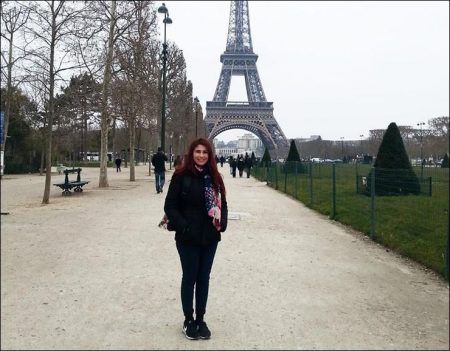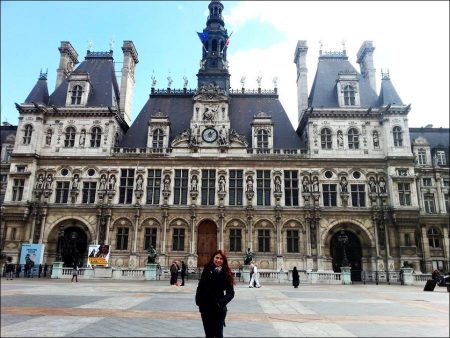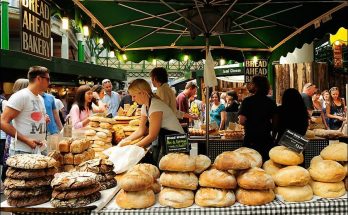Paris is a city where nature has never worn out her welcome, but continues to thrive even in the ultra-modern quarters. The Seine with its shady banks and sunny quays provides a perfect haven of flowers and greenery, while the whole city is dotted with parks and gardens. The Impressionists and after them the Fauves roamed Paris with eager, understanding eyes, recording the tremor of the trees along the avenues, the shimmering surface of the river, old walls glowing in the sun, chimney smoke gathering into wisps of cloud above the rooftops. On monuments mellowed by time the faintest shades of color flicker as if seen across a tenuous veil.
This unique light of Paris, made of sunshine and mist, gives every element its rightful place and tone in the panorama. Even the Eiffel Tower, modern times’ great contribution to the silhouette of Paris, blends with the monuments of the past, a soaring, bodiless piece of architecture giving the full measure of the sky above the city. The best painters of the present day no longer linger over anecdote and detail; their broad synthetic vision embraces the seen and unseen treasures of a city as rich in past glories as it is rich in promise for the future.
The earliest paintings in which we can identify actual views of Paris date from the transitional period from Romanesque to Gothic, when outline drawing was coming back into favor at the expense of the monumental style. Definitely on the way out were the lavish gold backgrounds we find, for example, in the Psalter of St Louis, in which the scenes take place beneath the pinnacles, rose-windows and pointed arches of the SainteChapelle. Manuscript painting moved on from blue-and-red to shadings of color, to lively, freehand drawing, to the checkered backgrounds typical of the Parisian ateliers.
The Life of St Denis, a manuscript written by a monk named Yves and offered in 1317 in three bound folios to Philip the Tall, was illuminated by an unknown artist. The entire legend of St Denis, first bishop of Paris, is illustrated in detail, from the time when, still a pagan, he ranked as one of the leading philosophers of Athens, to the days of his conversion and subsequent mission to Paris where, with his companions St Rusticus and St Eleutherius, he suffered martyrdom on the hill of Montmartre; from there, says the legend, carrying his severed head in his hands, he walked a few miles northward to the village of Catulliacum 10, today called St Denis.
Each scene of the saint’s life is coupled with vignettes which, taken together, give a remarkably complete picture of life in medieval Paris. We see boatmen on the Seine ferrying barrels of wine, and an angler in his boat drifting with the current. At the foot of the towers, beneath the city gates, we see the crowds on the Grand-Pont: money changers, goldsmiths, street porters, jugglers, showmen with bears and monkeys, beggars, rag-pickers, wine-hawkers–an image of everyday life in Paris that was to change little for many centuries to come.
Between these early works and the high achievement of the Limbourgs and Jean Fouquet, what do we find? The great intervening figure is that of Jean Pucelle, leading chef d’atelier of a Paris that even then, in the 14th century, was an international art center, a hive of busy studios where expert draftsmen and illuminators produced a wealth of exquisitely illustrated manuscripts. Pucelle’s finest work is the Belleville Breviary, whose vellum margins he covered with ivy sprigs and foliage, with butterflies, dragon-flies and snails, and a whole fauna of whimsical creatures painted with a finesse and poetic realism that recalls “both the edge of a garden patch and a masterpiece of the engraver’s tool”
Shortly after Pucelle’s death in 1380 (the same year in which Charles V died), there occurred the revolt of the Maillotins 12, during which the furious populace lynched the tax collectors. Even so the city preserved a semblance of good government for the next thirty years, and it was with a heavy heart that the great satirist and ballad writer Eustache Deschamps took leave of Paris and the pleasures she offered:
Adieu m’amour, adieu douces fillettes,
Adieu Grand Pont, hales, étuves, bains,
Adieu Paris, adieu petits pastez!
Deschamps died about 1406. In the coming years Paris endured rioting, epidemics, famine, and an English occupation. But this did not prevent such proud lords of the realm as the dukes of Anjou, Burgundy and Berry, brothers of Charles V, and Louis d’Orléans, his youngest son, from patronizing artists and collecting works of art as passionately as Charles himself had done. Their vast estates, despite the troubled times, were covered with palaces, castles and chapels in which jewels, tapestries, sculptures and paintings from all corners of Western Europe were amassed–collections of incalculable richness as is proved by the inventories of the time. The most famous and memorable of these art-loving princes is the Duke of Berry.
A strong-minded man, avid of novelty and refinements, the Duke of Berry was continually on the move from one of his castles to another, invariably accompanied by his pet swans and pet bears. An insatiable collector of beautiful things and an unrivaled spendthrift, unstinting with artists whose work he admired, and always eager to have his portrait painted by them, he was–for all his faults–wise enough to prefer to live on in the eyes of posterity not as one ruler of a petty realm amongst many such rulers, but as a generous patron of the arts at whose court the good things of life were enjoyed to the full.
It was for him that Pol de Limbourg and his brothers painted about 1416 the incomparably beautiful miniatures known as the Très Riches Heures, now at Chantilly. Views of Paris figure in the background of several scenes contained in this Book of Hours, notably the exquisite illustration of the month of June in the Calendar. Here we see the tip of the Ile de la Cité with, on the right, the Sainte-Chapelle emerging from beyond crenelated walls “like a gigantic reliquary” (Marcel Poète) and symbolizing that successful union of the holy and the worldly life realized by St Louis. This view was made from about where the presentday Mint stands.
Another scene from the Calendar (month of October) shows peasants plowing and sowing in the shadow of the Louvre. So it must have appeared in the heyday of Charles V, when the king, abandoning the Palace where ghostly memories of the recent murders perpetrated there by Etienne Marcel and his cohorts gave him no peace, took up his residence at the Louvre, a magnificent chaos of battlemented towers, pointed turrets and steeply pitched roofs covered with sheet lead or glazed tiles, and topped with tall weather-vanes, finials, gables and so on.
Visits: 202




